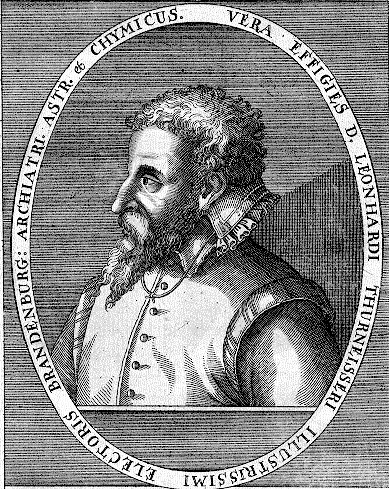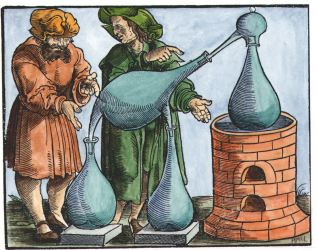| Author | Post |
|---|
adammclean
Member

| Joined: | Fri Sep 14th, 2007 |
| Location: | United Kingdom |
| Posts: | 606 |
| Status: |
Offline
|
|
Posted: Wed Oct 24th, 2007 09:01 am |
|
Last night when looking through my papers I happened upon an article in the Ciba Symposium for February 1942. Though this journal was devoted to pharmaceuticals, at that time it did have a number of articles on alchemy. This piece caught my eye. It gives an indication of the income of the late 16th century alchemist Leonhard Thurneysser zum Thurn. Thurneysser was one of the founders of the chemical industry that was emerging at that time. This short piece gives an account of some of the sources of his then considerable income.
WHAT DID AN ALCHEMIST EARN?
Information concerning the incomes of alchemists is very scanty, since they endeavored to hide such facts as much as their secret arts. However, we do have some knowledge of the earnings of one of the leading alchemists, Leonhard Thurneysser zum Thurn, a native of Basel (1530-1596).
As physician-in-ordinary to Georg Wilhelm, Elector of Brandenburg, he received annually the sum of 1352 thalers, an enormous honorarium at that time. In addition, he also received feed for his horses, clothing, emoluments in kind, as well as free lodging. He earned still more, however, through his alchemistic activities, which were so extensive that he maintained a staff of 200 people and traveled to his consultations in a carriage drawn by four teams of horses.
He put together medicine chests for travelers containing 120 medicaments prepared chiefly in his laboratory. For each of these medicine chests which he sold in large number, he received 386 thalers. Urine specimens that were sent to him from every country were examined for a fee of 10—15 thalers. One of his main occupations was the sale of tinctures, mixtures, inunctions, etc., which he made himself. These he sold at extremely high prices. Thus he sold a quantity of Spiritus vini, of about 17 grams, for 4 thalers; an equal amount of Spiritus vitrioli cost 6 thalers, Ol. Cinnamoni 12, Rhubarb extract 2, and of Tinctura Antimonii 16 thalers.
He demanded fantastic prices for his secret remedies such as amethyst tincture, ruby, sapphire, coral, or emerald tinctures. All these remedies were sold everywhere in great numbers.
Furthermore, Thurneysser earned enormous sums through the sale of calendars and horoscopes; thus the Count of Oettingen paid 100 gulden for one. In view of such fees it is not surprising to learn that in 1580 his fortune amounted to 100,000 gulden, an enormous sum at that time; in addition, he possessed 12,000 pieces of gold and nine hundred-weights of silver plate.
Ultimately, however, he lost everything in a lawsuit and died in poverty.
L. T.
Last edited on Wed Oct 24th, 2007 09:35 am by adammclean
|
adammclean
Member

| Joined: | Fri Sep 14th, 2007 |
| Location: | United Kingdom |
| Posts: | 606 |
| Status: |
Offline
|
|
Posted: Wed Oct 24th, 2007 09:40 am |
|
Here is a precis/extract of the biography of Thurneisser by John Ferguson in his Bibliotheca Chemica.
He began life by learning the trade of his father, who was a goldsmith, but he also picked up some knowledge of botany, medicine, and, possibly, anatomy under Vesalius. In 1548 he left Basel, and went to England, France, and Germany, where he became a soldier. Afterwards he worked as a metallurgist, and again as a goldsmith... From 1560 to 1570 he was in the service of the Archduke Ferdinand, and travelled far and near, from the Orkney islands down to Africa, and to the East, everywhere learning medicine and metallurgy... From 1570 to 1584 he was physician to John Georg, Churfürst of Brandenburg, and had a laboratory and printing press in the so-called "Grey monastery" at Berlin. By various means he amassed a large fortune, and at one time employed between two and three hundred people. He collected a library, a museum, and a herbarium, kept a menagerie, and encouraged the fine and practical arts, such as the manufacture of saltpetre, alum, glass, paper, and also coloured glass... in 1579, he was accused by Joel of magic and of having a devil in a bottle which taught him to write languages he did not know...In 1584 he finally left Berlin, went to Italy, where he tried to practice medicine and alchemy; he was at Rome in 1591, and died in a monastery at Cologne 9 July, 1596, and was buried beside Albertus Magnus, according to his own request.
Attached Image (viewed 864 times):
 Last edited on Wed Oct 24th, 2007 10:28 am by adammclean
|
Tom Willard
Member

| Joined: | Mon May 5th, 2008 |
| Location: | Tucson, Arizona USA |
| Posts: | 96 |
| Status: |
Offline
|
|
Posted: Tue May 6th, 2008 04:28 am |
|
| Leonhardt appears as a trickster figure (and something of an immortal adept) in one of E.T.A. Hoffmann's tales, "The Choosing of the Bride" (Die Brautwahl). Hoffmann's goldmaker produces an object we might all desire: a blank book that becomes whatever book one most wants to read.
|

Current time is 09:37 am | |
|
|
|

